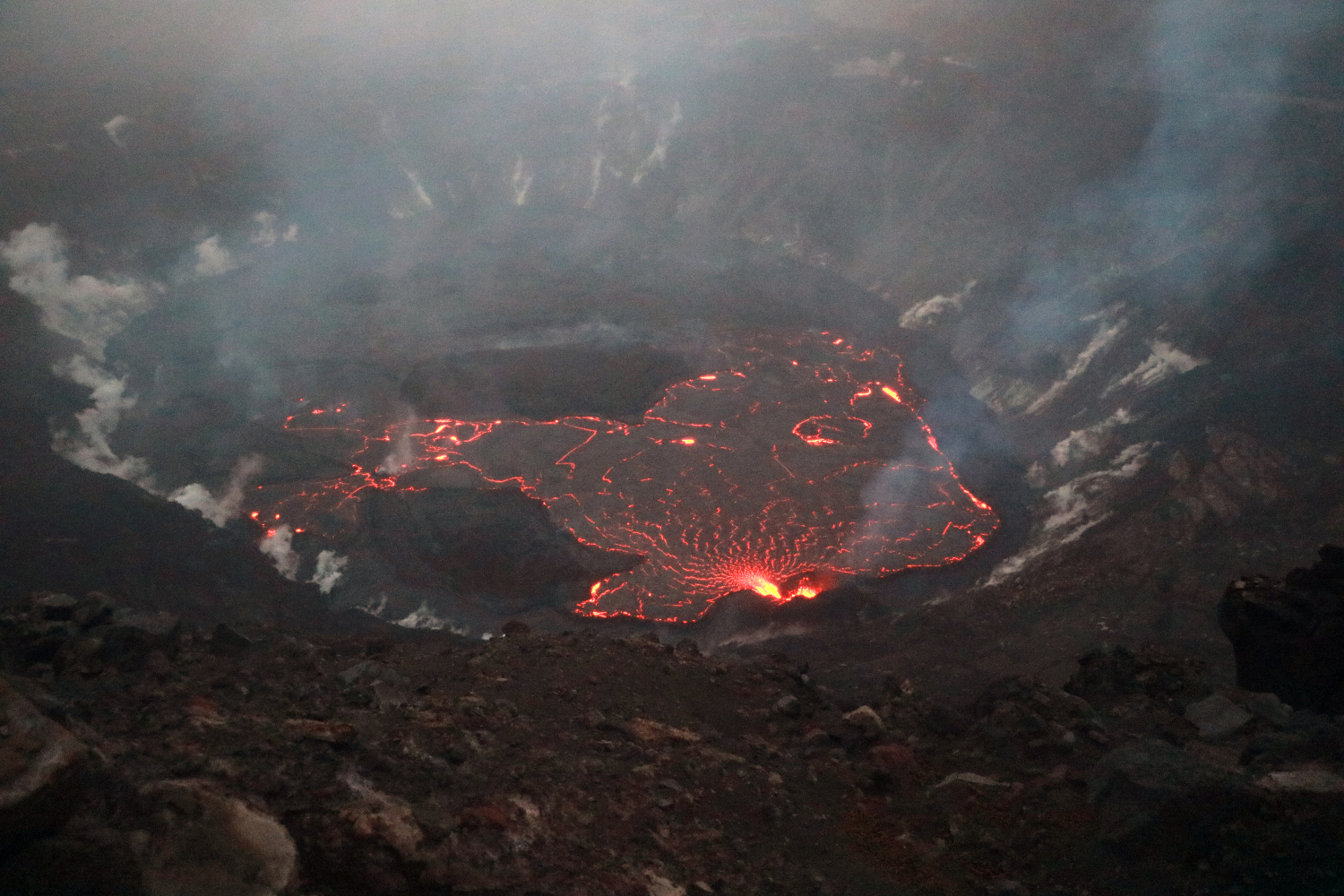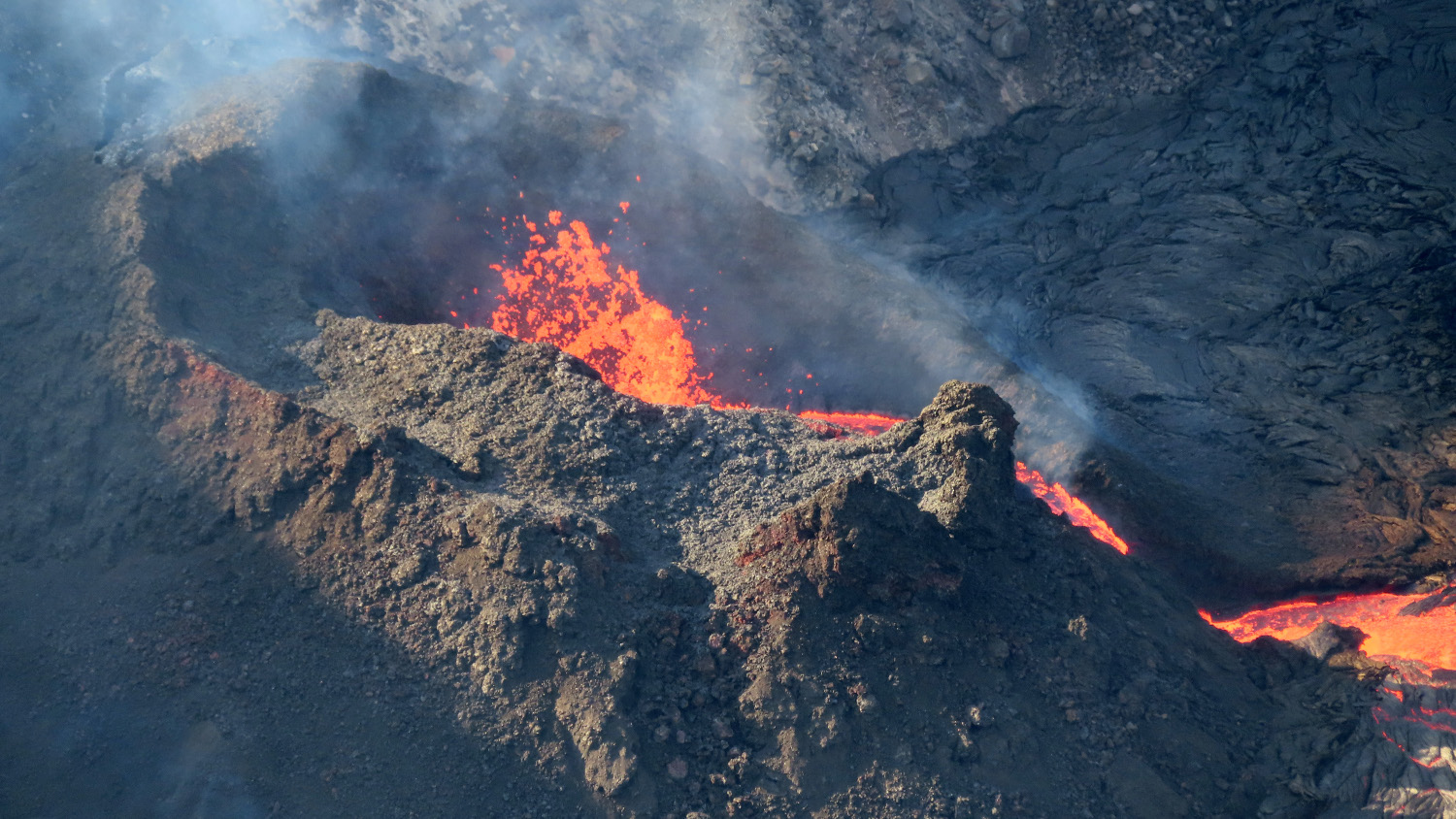
USGS: “A view of Halema‘uma‘u crater, at the summit of Kīlauea volcano, just after 6 a.m. HST on Saturday, October 23. Lava continues to erupt from the west vent into the lava lake at the base of the crater. Surface activity is limited to the west portion of the lake.” (USGS photo by K. Mulliken)
(BIVN) – As the eruption of Kīlauea volcano nears the one-month mark, the USGS Hawaiian Volcano Observatory today reported no dramatic changes in the summit activity.
From the USGS HVO:
Activity Summary: Kīlauea volcano is erupting. As of this afternoon, October 27, 2021, lava continues to erupt from a single vent in the western wall of Halemaʻumaʻu crater. All lava activity is confined within Halemaʻumaʻu crater in Hawai‘i Volcanoes National Park. Seismic activity and volcanic gas emission rates remain elevated.
Summit Observations: Sulfur dioxide (SO2) emission rates remain high, with a preliminary emission rate for October 25, 2021, of at least 2,600 tonnes per day. No significant changes seen in summit tilt or GPS observations. Earthquake activity remains below background and volcanic tremor remains elevated since the beginning of the eruption.
Halemaʻumaʻu Lava Lake Observations: Lava continues to erupt from a single vent in the western wall of Halemaʻumaʻu crater. The western end of the lake showed a maximum elevation of approximately 794 meters (2605 ft) above sea level by HVO’s permanent laser rangefinder on October 27, 2021, which is 1 m (3 ft) higher than yesterday, and a total increase of about 50 meters (164 ft) since lava emerged on September 29. The total erupted volume since the beginning of the eruption was estimated to be about 19.9 million cubic meters (5.3 billion gallons) on October 15. Fountain heights at the western vent were typically less than 10 m (33 ft) high as observed by field crews on October 27, 2021. The lava lake is not level across its surface due to the location of the vent in the western end. There is about 8 meters (26 feet) elevation difference between the active west and stagnant east part of the lake as measured by field crews on October 25, 2021.
East Rift Zone Observations: No unusual activity has been noted in the Kīlauea East Rift Zone. Ground deformation measurements in the upper East Rift Zone area—between the summit and Puʻuʻōʻo—suggest that refilling of magma since late August, 2021 has slowed or decreased slightly. SO2 and hydrogen sulfide (H2S) emissions from Puʻuʻōʻō were below instrumental detection levels when last measured on January 7, 2021.
Hazard Analysis: This new eruption at Kīlauea’s summit is occurring within a closed area of Hawai’i Volcanoes National Park. Therefore, high levels of volcanic gas are the primary hazard of concern, as this hazard can have far-reaching effects down-wind. Large amounts of volcanic gas—primarily water vapor (H2O), carbon dioxide (CO2), and sulfur dioxide (SO2)—are continuously released during eruptions of Kīlauea Volcano. As SO2 is released from the summit, it reacts in the atmosphere to create the visible haze known as vog (volcanic smog) that has been observed downwind of Kīlauea. Vog creates the potential for airborne health hazards to residents and visitors, damages agricultural crops and other plants, and affects livestock. For more information on gas hazards at the summit of Kīlauea, please see (this page). Vog information can be found at vog.ivhhn.org.
Additional hazards include Pele’s hair and other lightweight volcanic glass fragments from the lava fountains that will fall downwind of the fissure vents and dust the ground within a few hundred meters (yards) of the vent (s). Strong winds may waft lighter particles to greater distances. Residents should minimize exposure to these volcanic particles, which can cause skin and eye irritation.
Other significant hazards also remain around Kīlauea caldera from Halemaʻumaʻu crater wall instability, ground cracking, and rockfalls that can be enhanced by earthquakes within the area closed to the public. This underscores the extremely hazardous nature of Kīlauea caldera rim surrounding Halemaʻumaʻu crater, an area that has been closed to the public since early 2008.


by Big Island Video News11:33 am
on at
STORY SUMMARY
HAWAIʻI VOLCANOES NATIONAL PARK - The current eruption of Kīlauea began at 3:21 p.m. HST on September 29, 2021, and has remained confined to Halemaʻumaʻu crater.